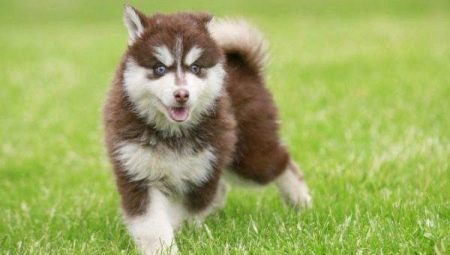Perhaps not everyone knows about the existence of dogs with such an unusual name - Pomsky. This rather expensive decorative breed is widely popular among specialists and breeders; it is in great demand in European countries and the USA. In Russia, Pomskis are just beginning to gain fame from dog breeders.
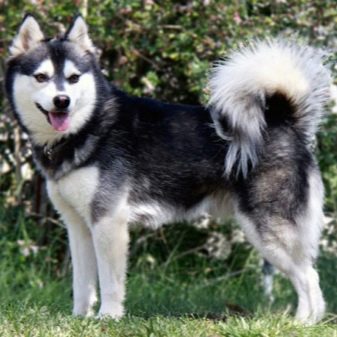
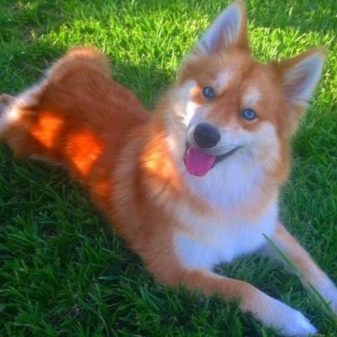
Appearance story
Crossbreeding of dogs of various breeds has long been widely used in dog breeding. Its purpose is to create a hybrid with certain characteristics of the character, other working abilities or with a characteristic exterior. The bred hybrid has the properties of both of its parents of different breeds, and sometimes representatives of several breedswhich were used for hybridization.
Pomsky is a representative of a crossed breed that appeared as a result of hybridization of a Pomeranian and Siberian Husky. Her goal was to create a miniature breed for home keeping as a companion dog.
As a result of lengthy experiments, a unique dog of its kind appeared that inherited from its parents only the best positive qualities. The new hybrid is called Pomsky: the word came about as a result of combining abbreviations from “Pomeranian” and “Husky”.

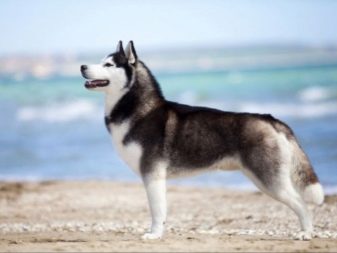
For the first time, information about a dog, which is a mixture of Spitz and Husky breeds, appeared on the Internet, where a user was interested in the characteristics of the character and the probable diseases of this mestizo. The web instantly responded with heated debate about the real possibility of breeding such a breed, because parents have such different dimensions.
The idea of creating an unusual breed, so actively discussed on the Web, prompted breeders to begin experiments. One of such experimenters was the famous American breeder Teresa Peterson, whose specialization is a husky dog. In 2013, she bred the first hybrid litter. These first puppies were officially registered.
Following Peterson, many other dog breeders also began to breed these cute dogs. There were so many of them that it became advisable to establish an organization that controls the activities of breeders.
In 2013, the PCA - American Pomsky Club became such a body., which aims to maintain this breeding species at the necessary and worthy level and achieve recognition of this mestizo as an independent breed, having its own individual standard.
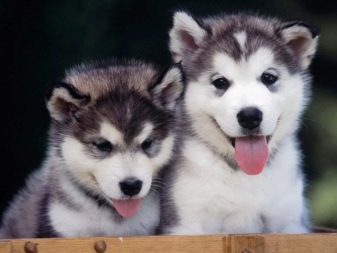
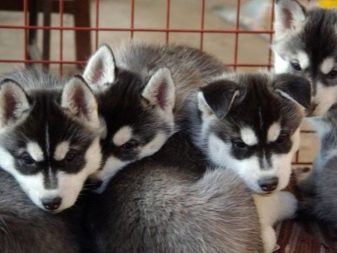
The peculiarity of breeding a cross between a husky and a Pomeranian is that Siberian husky always acts as a mother. Miniature Spitzs are simply unable to endure and safely give birth to such large cubs for them. Insemination is always carried out artificially.
At present, the Pomsky is still not a breed recognized by world dog handlers' societies. The breeding work of dog breeders is supported exclusively by the American Club of Hybrid Dogs (ASNS) and PCA.


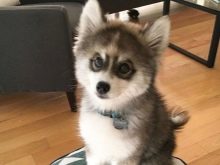
Breed description
Metis inherited its small size from the Pomeranian spitz, and from the husky - the color of the coat and a kind of distinctive "mask" on the face. The color of the wool is diverse: the pomks are black and red, gray and white, brown, gray with a silver tint and fawn. The color of the coat is not only solid monophonic, but also with tan or spots, and sometimes marble.
The most common breed is the color typical of a husky - gray-white.
His coat is thick, fluffy, soft, of medium length. A thicker, shorter and warmer undercoat protects against cold and moisture, and the upper long and durable coat of wool protects against pollution.
The color of the eyes that they inherited from the husky can also be different: blue and green, brown and hazel. Quite often there are cases when the iris of the eyes is colored differently: heterochromia is also often found in husky.
Heterochromia in pomsky can be in such variants:
- “Harlequin” - eyes are colored differently, for example, one eye is blue and the other is brown;
- marble color - against the background of the main color of the iris, specks and blots of a different shade are scattered;
- individual sections of the iris have different shades.

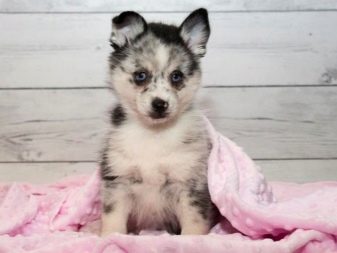
The exterior of the dog can also be different and depends on the genes of which parent dominate. The variability of its appearance is also due to the fact that purebred parents are used in hybridization. Given the great variety of appearance, this breed is conditionally divided into several groups.
- Fox look. Poms of this type have an elongated torso (like that of a Siberian husky), thin, like that of an orange, a skeleton, a pointed muzzle, protruding ears and smooth red hair with a reddish tint. With all its appearance it is very similar to a fox.
- Plush type pomsky. Dogs have a small body, characteristic of a spitz, a short blunt muzzle, soft, dense and longer hair, painted in shades typical of a husky, and a thick tail twisted into a ring.
- White Pomsky. This species is very rare, it is distinguished by larger sizes, plain wool of pure white color and sophisticated outlines of the muzzle.
- Brown mestizo with blue eyesalso being a rare species. The dog has a dense strong skeleton, a muzzle of medium length, not very long coat with a dense undercoat, painted in brown tones. The dog’s nose is also brown.
- Shorthair look. It looks like a husky in miniature with thick but short hair.
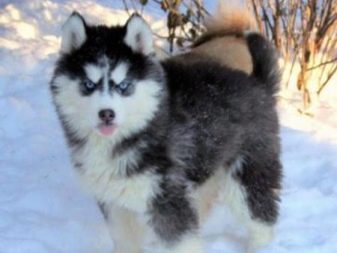
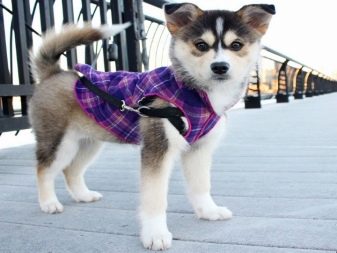
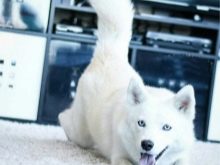
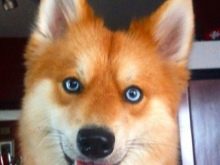

The weight category is also different. The size and weight of a dog is influenced by factors such as gender, dimensions of the parents, the number of puppies in the litter and its generation. Usually, boys are 1-2 kg larger than girls and outnumber them by about 5-10 centimeters.
Dogs of the first generation (F1), whose parents are purebred Spitz and Husky, can weigh from 4 to 12 kg. F1 puppies inherit the parental characteristics of appearance in equal amounts and look 50% like husky dogs and 50% like oranges.
The second-order adult half-breed is the result of crossbreeding F1. It can have a weight of 4 to 10 kg. Predicting the color and size of second-generation dogs is much simpler.
The expected weight of the dog can be determined by halving the total weight of the two parents.

The growth of adult dogs is small and can range from 25 to 40 cm at the withers.
Mestizos usually don’t get their diseases from their parents. They have increased vitality and good health, characteristic of first-order hybrids. But this does not mean that they do not get sick at all. Diseases are most often the result of improper care and nutrition. In addition, they are prone to allergies.
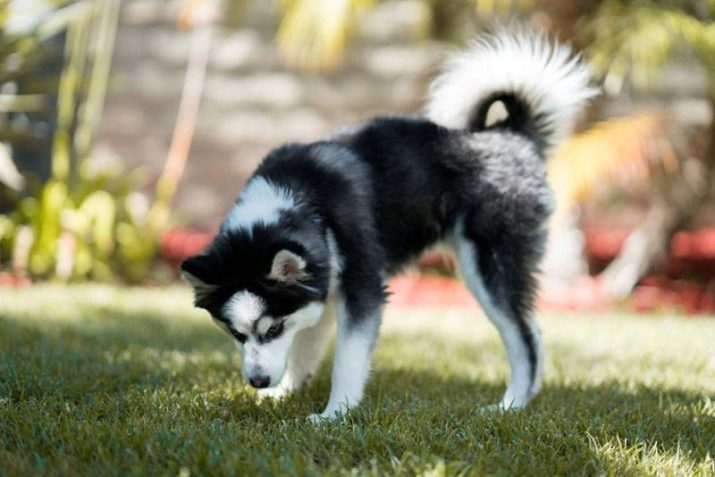
Nature and behavior
Taking from parents their positive character traits, mestizos have a peace-loving, affectionate, joyful and cheerful disposition. Their behavior is friendly, non-aggressive and calm. They show harmless curiosity to strangers, but at the same time they themselves are not afraid and are ready to rush at anyone to protect the owner.
These are very mobile and active dogs, loving games, especially with children. They will never harm children, even through indiscretion.
They live friendly with other pets, even cats, especially if they grew up together. An exception are rodents, which they perceive as a subject of hunting. They do not show anxiety if they are left alone, they can calmly stay alone for several hours.
Dogs do not require increased attention, content with the manifestations of love and affection that their owner provides. They feel good both in a single owner and in a large family.
However, the Pomsky always chooses a pet for himself, who will become for him a little more authority.
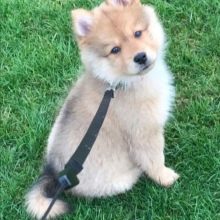
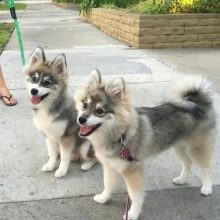

Attachment to the owner is even greater than that of the Husky, but the mestizo is more independent than the Spitz: he does not need to constantly stay with the owner. On a walk, she never initiates quarrels with other dogs.
Negative manifestations of their temper are also observed. During walks, a predisposition to escape can manifest itself, when his curiosity can end either with a fun adventure, or some kind of trouble. These dogs are big lovers of digging holes in flower beds and beds, and they can also make a complete mess of spoiled and everywhere scattered things at home.
These pets can exhibit in their character any features of the behavior of the Spitz and Husky, as well as acquire over time their own in accordance with the surrounding reality.

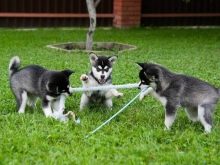

Care Features
Dogs of this domestic breed exist wonderfully in the city, in any apartment, and in a private house, but they are not adapted to live on the street. In the apartment, the pet must have a private place to sleep and rest. This can be any room where he is allocated a place with soft bedding.
The dog does not require any special care.
The main requirements for the maintenance of the pet are regular walking, hair care, periodic preventive visits to the veterinarian.
Visits to the veterinary clinic are recommended to be carried out according to the schedule: a healthy dog needs only two visits per year. Mestizos are vaccinated in the same way as dogs of other breeds. At the age of 6-8 weeks, they need to get their first vaccine. Prevention from external and intestinal parasites is carried out every 3 months.
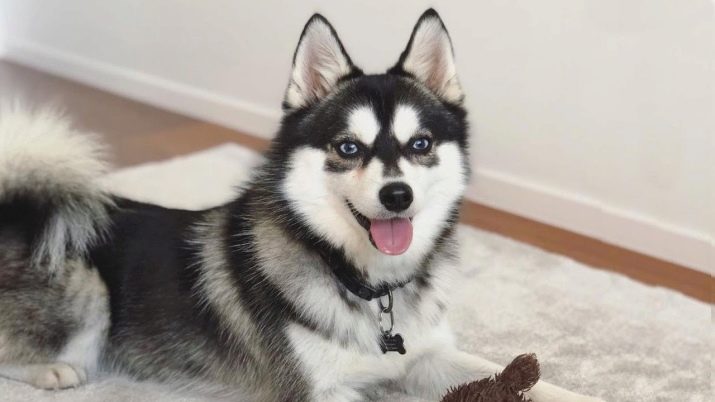
A pet kept at home needs regular and long walks during which it needs to lose its stored energy. Activity in dogs is individual and corresponds to their size: the larger the dog, the more he needs physical activity.
Each dog needs to be walked 2 times a day and loaded with physical activity, which only improves the well-being of the pet. The duration of the walk should be at least an hour. Running is especially useful for them, so it should take a lot of time on a walk.
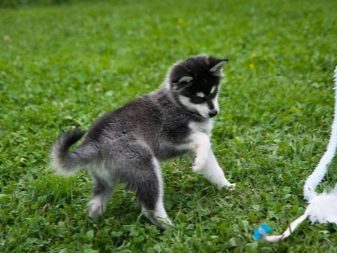

The unique ability of mestizo wool protects them from dirt and water, so dogs do not need to bathe very often. It is recommended to bathe them 1-2 times a month using shampoos designed specifically for dogs. After bathing your pet, you must thoroughly wipe it with a soft towel, and then dry the hair with a hairdryer.
However, its thick coat needs regular brushing about 2-3 times every 7 days. During molting, which happens twice a year (in spring and autumn), combing must be done every day using a brush with natural bristles.
It is especially necessary to take care of the hair near the muzzle and near the ears, since here most often the wool falls off and wool lumps form. Dogs do not need a haircut, only trimming between the toes is possible.
Mandatory is hygienic care for the eyes and ears of the animal. The contamination in the ears is removed using clean swabs moistened with a special lotion, which can be purchased at a veterinary pharmacy. It is also necessary to cut the nails as they grow back about once a month. The teeth of the pet also need to be taken care of: they need to be often (several times a week) cleaned with special toothpaste.
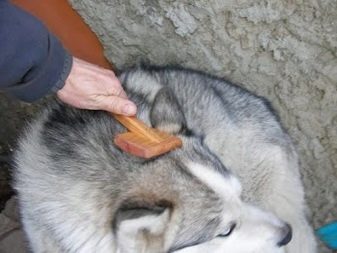
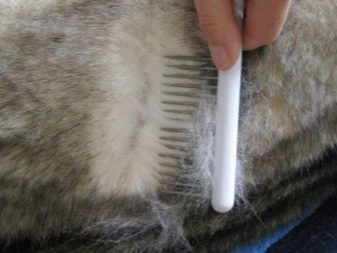
An interesting feature is inherent in dogs of this breed - they lick wool, like cats.
Feeding rules
The nutrition of dogs of this breed is no different from the nutrition of other dogs. Since Pomsky belong to the category of active dogs, the nutrition should be complete, properly balanced, high-calorie. A natural type of food is recommended for these pets, but dry feed is also possible.
Natural nutrition should include foods high in vitamins, trace elements and be of average calorie content. This is achieved by controlling the carbohydrate content. Natural nutrition must be supplemented with mineral and vitamin complexes in order to provide the animal with a daily norm of vitamins and minerals.
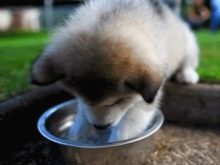

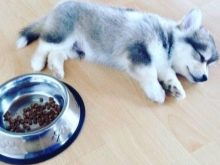
The basic rule of feeding mestizos is to comply with the required content and the correct ratio of nutrients: proteins, fats, carbohydrates, minerals and vitamins. A large proportion of the diet belongs to proteins that are found in meat and fish. Meat products should be up to 60% of the total daily diet.
A pet can be given such products:
- lean meat - veal, turkey, chicken, rabbit;
- offal - scar, heart, chicken liver, stomach;
- sea fish;
- cereals in the form of porridge - rice, oatmeal, buckwheat;
- low-fat lactic acid products - natural yogurt, kefir, fermented baked milk, cottage cheese;
- vegetable vegetables are very useful squash, beets and carrots, stewed cabbage, pumpkin;
- fruits - bananas, apricots, apples and pears;
- greens - dill, parsley and salad.
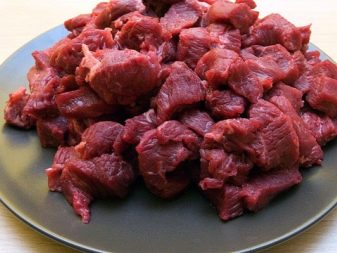
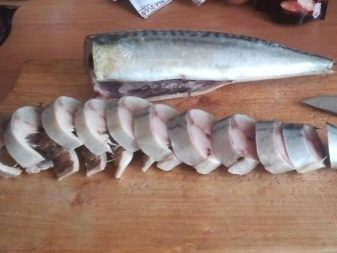
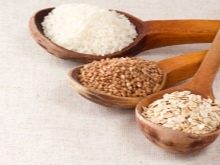


Meat ingredients are usually given along with cereal cereals or boiled vegetables. Porridge should be boiled in water, they can not be salted. Salt is permissible only in very small quantities.
It is permissible to give an egg no more than twice a week. Fish is also rarely given - once a week. It should be noted that meat, offal and fish are given only in boiled form.
Vegetable oils (sunflower, olive, corn) are useful to add to the finished food.


Pomsky prohibited such products:
- pork and lamb, any other raw meat and raw fish;
- any fatty and spicy dishes and smoked meats;
- confectionery, chocolate, pastry;
- spices and pickles;
- potatoes and any beans.
It is strictly forbidden to give dogs tubular chicken bones. Sharp bone fragments can injure the stomach and intestines.
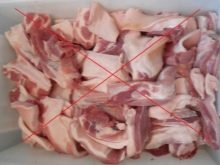
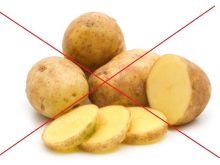

Feeding adult pets is carried out twice a day: morning and evening.
The advantage of dry prepared feeds is that they already contain all the necessary nutrients, vitamins and are properly balanced. There is also no need for counting calories. For dogs of this breed, you need to choose only super-premium food, as these are the highest quality food. Economy class food is strictly prohibited.
It is also recommended to constantly feed with the feed of the same brand. Frequent changes in the brand of food can cause digestive system diseases. When eating dry food, fresh water should always be in unlimited quantities and available to the dog.
Dry food can sometimes be supplemented with wet - canned food, pastes, which have different taste shades.
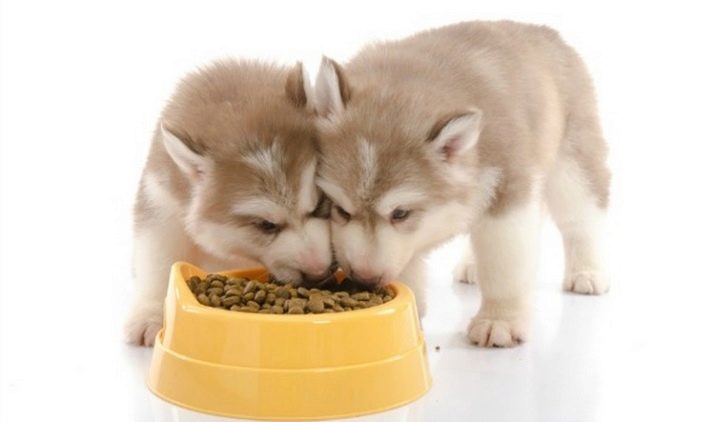
Parenting and training
Pomsky is distinguished by a highly developed intellect, which they inherited from both of their parents. Mestizos are easy to train. They assimilate and execute many commands, understand their owner very well, love to be praised.
But individual specimens are able to show the independence inherent in the Siberian parent, which often leads to atypical solutions to the problem and affects the training.
Only with patience and kind attitude can a pet obediently and accurately execute a command. A rude attitude can make him nervous and uncommunicative.
The metis has psychological sensitivity: it perfectly understands the emotional mood of the owner and easily adapts to it. He reacts negatively to screaming and even more so to physical punishment and, despite his rather stable nervous system, becomes touchy and uncontrollable, and can be stubborn.
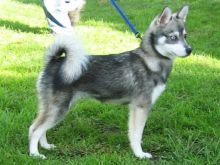
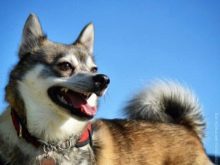
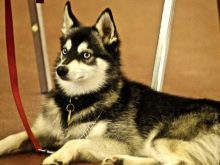
Since this is still a fairly young and rare breed, dog handlers cannot offer any specific and specific advice on education and training. However, the method of unobtrusive involvement in the learning process with game elements is always effective. The pet is quite available to execute simple standard commands. Having mastered the team, he shows attention and diligence.
You need to start training and raising a dog from the age of 6 months. There are certain rules that must be followed.
- You need to start training with the simplest teams in a game form on the principle - from simple to more complex.
- Take into account the individual abilities of the pet - not all dogs are able to fulfill the command the first time. In case of failure, persistence and repetition must be shown.
- Training is best done at home after a walk: at this time the dog is in a good mood.
- Successful completion of the team must be encouraged by the delicacy. For failure can not be punished and scolded.
- Teams need to be constantly and unobtrusively repeated in everyday life.
- Training is recommended in the intervals between feedings, but not after them.
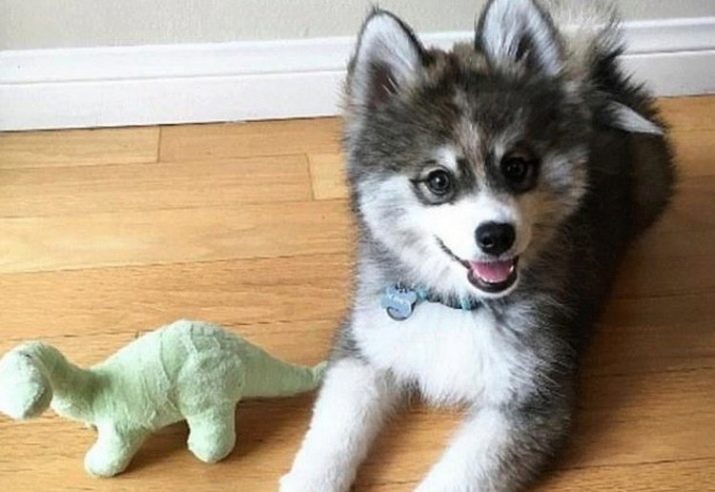
Raising a dog should also be accompanied by the following requirements:
- the pet should never be near during the meal of the owners, especially since it is impossible to give him food from the table;
- it is necessary to forbid him to sleep on the bed of his masters, not to be allowed to sit in their chair;
- the dog must clearly know its place in the apartment.
Pomsky is quite capable of learning such standard commands as “To Me” and “Place”, “Nearby” and “Sit”, “Lie”, “Give” and “Aport”, which also prohibit “Fu”, “No” and “It is impossible ". On a walk, you can teach him to understand and perform "Walk", "Barrier", "Crawl".
Training any dog, including a dog, is a long and rather laborious process, requiring a lot of patience and perseverance from the owner.
Those who wish to have a puppy of this unusual breed at home are advised to first familiarize themselves with the character and behavior of their parents, the Siberian Husky and the Pomeranian, as the pet can unpredictably inherit any positive or negative trait of their behavioral characteristics.
You can get to know these cute dogs in the next video.
